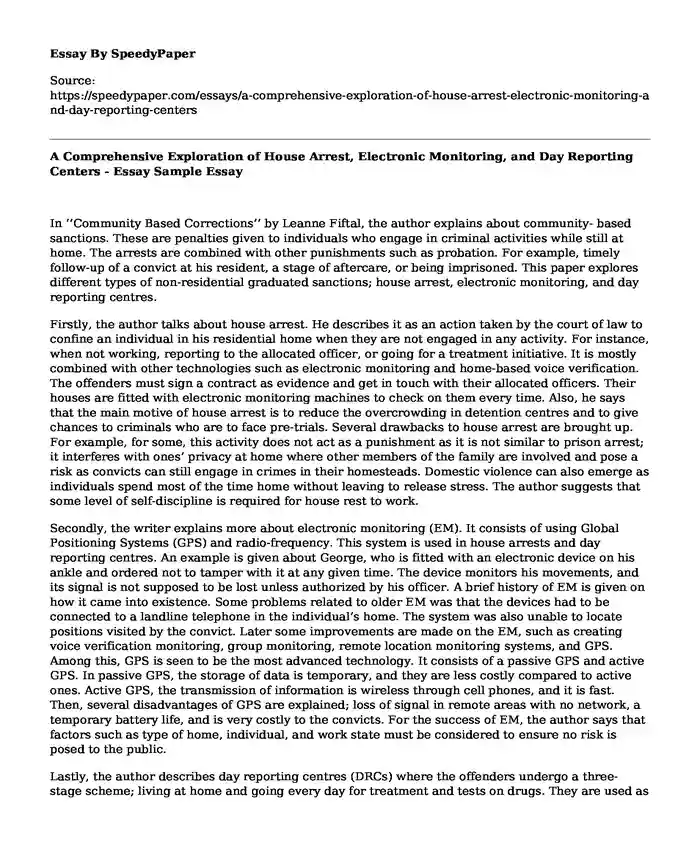In ‘’Community Based Corrections’’ by Leanne Fiftal, the author explains about community- based sanctions. These are penalties given to individuals who engage in criminal activities while still at home. The arrests are combined with other punishments such as probation. For example, timely follow-up of a convict at his resident, a stage of aftercare, or being imprisoned. This paper explores different types of non-residential graduated sanctions; house arrest, electronic monitoring, and day reporting centres.
Firstly, the author talks about house arrest. He describes it as an action taken by the court of law to confine an individual in his residential home when they are not engaged in any activity. For instance, when not working, reporting to the allocated officer, or going for a treatment initiative. It is mostly combined with other technologies such as electronic monitoring and home-based voice verification. The offenders must sign a contract as evidence and get in touch with their allocated officers. Their houses are fitted with electronic monitoring machines to check on them every time. Also, he says that the main motive of house arrest is to reduce the overcrowding in detention centres and to give chances to criminals who are to face pre-trials. Several drawbacks to house arrest are brought up. For example, for some, this activity does not act as a punishment as it is not similar to prison arrest; it interferes with ones’ privacy at home where other members of the family are involved and pose a risk as convicts can still engage in crimes in their homesteads. Domestic violence can also emerge as individuals spend most of the time home without leaving to release stress. The author suggests that some level of self-discipline is required for house rest to work.
Secondly, the writer explains more about electronic monitoring (EM). It consists of using Global Positioning Systems (GPS) and radio-frequency. This system is used in house arrests and day reporting centres. An example is given about George, who is fitted with an electronic device on his ankle and ordered not to tamper with it at any given time. The device monitors his movements, and its signal is not supposed to be lost unless authorized by his officer. A brief history of EM is given on how it came into existence. Some problems related to older EM was that the devices had to be connected to a landline telephone in the individual’s home. The system was also unable to locate positions visited by the convict. Later some improvements are made on the EM, such as creating voice verification monitoring, group monitoring, remote location monitoring systems, and GPS. Among this, GPS is seen to be the most advanced technology. It consists of a passive GPS and active GPS. In passive GPS, the storage of data is temporary, and they are less costly compared to active ones. Active GPS, the transmission of information is wireless through cell phones, and it is fast. Then, several disadvantages of GPS are explained; loss of signal in remote areas with no network, a temporary battery life, and is very costly to the convicts. For the success of EM, the author says that factors such as type of home, individual, and work state must be considered to ensure no risk is posed to the public.
Lastly, the author describes day reporting centres (DRCs) where the offenders undergo a three-stage scheme; living at home and going every day for treatment and tests on drugs. They are used as a form of punishment where one staff serves approximately fourteen clients. Frequently, offenders who pose a high risk are accepted here, for example, sex offenders and offenders who are mentally ill. Most DRCs are treatment-oriented and supervision oriented. Treatment-oriented focus more on skills needed for employment and education on drugs while supervision-oriented work towards keeping clients busy and ensuring they follow the rules. The writer states that the completion rate in DRCs is a bit lower than other programs due to the pressure of having to report daily.
In conclusion, the author communicates that there is no given way to run a DRC or any of the programs discussed above. Each initiative has its own set goals and distinct clients. The main aim is to set the objectives of a program and evaluate its success and see whether it improves the quality of living for the victims.
References
Alarid, L. F. (2016). Community based corrections. Cengage Learning.
Cite this page
A Comprehensive Exploration of House Arrest, Electronic Monitoring, and Day Reporting Centers - Essay Sample. (2023, Dec 26). Retrieved from https://speedypaper.net/essays/a-comprehensive-exploration-of-house-arrest-electronic-monitoring-and-day-reporting-centers
Request Removal
If you are the original author of this essay and no longer wish to have it published on the SpeedyPaper website, please click below to request its removal:
- Article Analysis Essay: Son Charged With Murder in Death of Connecticut Couple
- Essay Sample on Officers and Their Interaction with the Black Community
- Criminal Law Foundations Evaluation in Our Free Essay
- Law Essay Sample Dedicated to the Fourth Amendment
- Essay Example on Famous Killer in Canada: Allan Legere
- Essay Sample Dedicated to LGBT in Japan
- Essay Sample on Description of the Computer Crimes
Popular categories





